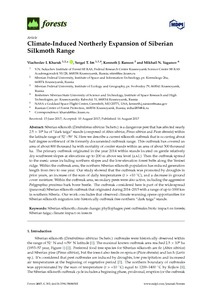Climate-Induced Northerly Expansion of Siberian Silkmoth Range
DOI:
10.3390/f8080301URI (для ссылок/цитирований):
http://www.mdpi.com/1999-4907/8/8/301https://elib.sfu-kras.ru/handle/2311/69765
Автор:
Viacheslav I. Kharuk
Sergei T. Im
Kenneth J. Ranson
Mikhail N. Yagunov
Коллективный автор:
Институт космических и информационных технологий
Институт экологии и географии
Базовая кафедра геоинформационных систем
Кафедра географии
Дата:
2017-08Журнал:
ForestsКвартиль журнала в Scopus:
Q1Квартиль журнала в Web of Science:
Q1Библиографическое описание:
Viacheslav I. Kharuk. Climate-Induced Northerly Expansion of Siberian Silkmoth Range [Текст] / Viacheslav I. Kharuk, Sergei T. Im, Kenneth J. Ranson, Mikhail N. Yagunov // Forests. — 2017. — Т. 8 (№ 8).Аннотация:
Siberian silkmoth (Dendrolimus sibiricus Tschetv.) is a dangerous pest that has affected nearly 2.5 × 106 ha of “dark taiga” stands (composed of Abies sibirica, Pinus sibirica and Picea obovata) within the latitude range of 52°–59° N. Here we describe a current silkmoth outbreak that is occurring about half degree northward of its formerly documented outbreak range. This outbreak has covered an area of about 800 thousand ha with mortality of conifer stands within an area of about 300 thousand ha. The primary outbreak originated in the year 2014 within stands located on gentle relatively dry southwest slopes at elevations up to 200 m above sea level (a.s.l.) Then the outbreak spread to the mesic areas including northern slopes and the low-elevation forest belts along the Yenisei ridge. Within the outbreak area, the northern Siberian silkmoth population has reduced generation length from two to one year. Our study showed that the outbreak was promoted by droughts in prior years, an increase of the sum of daily temperatures (t > +10 °C), and a decrease in ground cover moisture. Within the outbreak area, secondary pests were also active, including the aggressive Polygraphus proximus bark borer beetle. The outbreak considered here is part of the wide-spread (panzonal) Siberian silkmoth outbreak that originated during 2014–2015 with a range of up to 1000 km in southern Siberia. Our work concludes that observed climate warming opens opportunities for Siberian silkmoth migration into historically outbreak free northern “dark taiga” stands.
Коллекции:
Метаданные:
Показать полную информациюСвязанные материалы
Показаны похожие ресурсы по названию, автору или тематике.
-
Fir Decline and Mortality in the Southern Siberian Mountains
Viacheslav I. Kharuk; Sergei T. Im; Ilya A. Petrov; Mariya L. Dvinskaya; Elena V. Fedotova; Kenneth J. Ranson (2017)Increased dieback and mortality of ‘‘dark needle conifer’’ (DNC) stands (composed of fir (Abies sibirica), Siberian pine (Pinus sibirica) and spruce (Picea obovata)) were documented in Russia during recent decades. Here we ... -
The effect of individual genetic heterozygosity on general homeostasis, heterosis and resilience in Siberian larch (Larix sibirica Ledeb.) using dendrochronology and microsatellite loci genotyping
Babushkina, E. A.; Vaganov, E. A.; Grachev, A. M.; Oreshkova, N. V.; Belokopytova, L. V.; Kostyakova, T. V.; Krutovsky, K. V. (2016-03)The genetic mechanisms underlying the relationship of individual heterozygosity (IndHet) with heterosis and homeostasis are not fully understood. Such an understanding, however, would have enormous value as it could be ... -
Wildfires Dynamics in Siberian Larch Forests
Харук, Вячеслав Иванович; Пономарев, Евгений Иванович; Ranson, Kenneth J. (2016-06)Wildfire number and burned area temporal dynamics within all of Siberia and along a south-north transect in central Siberia (45–73 N) were studied based on NOAA/AVHRR (National Oceanic and Atmospheric Administration/ ... -
Spatial and temporal dynamics of Siberian silk moth large-scale outbreak in dark-needle coniferous tree stands in Altai
Kharuk, V. I.; Demidko, D. A.; Fedotova, E. V.; Dvinskaya, M. L.; Budnik, U. A. (2016-11)The spatial and temporal dynamics of fir stands damage caused by a large-scale outbreak of the Siberian silk moth (Dendrolimus sibiricus Tschetv.) in the Altai Mountains has been studied using remote sensing and GIS methods. ... -
Warming Effects on Pinus sylvestris in the Cold–Dry Siberian Forest–Steppe: Positive or Negative Balance of Trade?
Tatiana A. Shestakova; Jordi, Voltas; Matthias, Saurer; Rolf T. W. Siegwolf; Alexander V. Kirdyanov (2017-12)Understanding climate change impacts on drought-prone forests is a critical issue. We investigated ring-width and stable isotopes (d13C and d18O) in two Pinus sylvestris stands of the cold–dry Siberian forest–steppe growing ...

